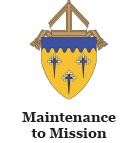The Diocese of Superior’s Maintenance to Mission initiative, launched by Bishop James P. Powers in 2021, is entering its fourth year and gaining momentum. It aims to shift an old paradigm as we move from maintaining existing Catholic Church structures to actively engaging in the Great Commission, “Go and make disciples.”
A new Diocesan Plan will be released on Tuesday, Feb. 18, first to priests and deacons, then to the wider community. This plan will provide further direction from Bishop Powers, guiding the diocese to move forward on mission. The journey may be challenging, but with our shared prayer and commitment, we can become a more vibrant, life-giving and holy church in the Diocese of Superior.
Our diocese is not unique in the renewed evangelization; nearly every archdiocese and diocese in the state and nation are grappling with making disciples. Pope Francis said, “Go out. Go out and share your testimony. Become the Word in body as well as in spirit.”
Across the diocese, the current call for parishes is:
* A challenge to “keep the main thing the main thing!” What is the main thing? Jesus, the Gospel and evangelization.
* Establish and/or continue work with Parish Evangelization Teams.
* Continue reviewing data provided by the diocese.
* Collaborate and utilize available resources.
* Attend events.
Current focus
At the diocesan level, Bishop Powers and his staff are focused on these goals:
Cultural Shift: Moving from a maintenance mindset (focused on buildings and programs) to a mission-oriented culture. This involves evaluating all activities through the lens of evangelization and the Great Commission. Parishes are asked to honestly assess if their efforts are focused on internal preferences or spreading the Kingdom of God. Simply maintaining Mass times or keeping buildings open is not sufficient.
Eucharistic Revival and World Synod: These have been key Vatican opportunities over the past three years to refocus on Christ Jesus in the Eucharist and listen to the people, and both have been mission driven.
Parish Evaluation: The Planning Team provides parishes with data and unique ratings graphs to evaluate needs and how to best move forward. This may lead to changes in programs, Mass times, and lay involvement in parish governance. Some parishes with minimal activity (low Mass attendance, few sacraments, limited evangelization) will need to find new ways to become more vibrant and life-giving.
Collaboration: Encouraging a shift from local, parish-level thinking with broader, diocesan-level thinking, with the potential for shared resources, different Mass schedules and evangelization education and research.
Moving forward
According to Director of Administration Dan Blank and Director of Development Steve Tarnowski, once the new plan has been disseminated, Bishop Powers will ask parishes to self-evaluate, discern new pathways to evangelization and present a plan for the future.
Blank and Tarnowski said officials hope to see isolated churches more united with their cluster parishes and diocesan church; “an emphasis on planting seeds” of evangelization among parishioners and seeing them grow in the community, as Bishop Powers explained in his “Pastoral Letter on Evangelization;” and a focus on finding a new sense of mission rather than simply maintaining old programs.
They added that Bishop Powers’ intent is not to close churches – rather, he hopes struggling parishes will use their resources to reenergize their parishioners and wider communities. Blank said there is a possibility that a couple of smaller churches could be reclassified as “oratories” in the future, meaning the buildings would remain available for sacraments and events without regular Masses – if a group of people committed to maintaining the building – but this would result if the parish concluded, in its own self-evaluation, that it was the best course of action.
A longer article detailing the new Diocesan Plan will be printed in the next issue of the Superior Catholic Herald.

